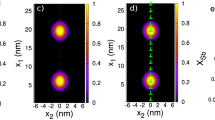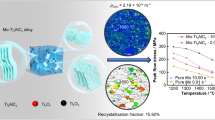Abstract
Based on the theory of micro-inhomogeneity of liquid metal, a calculation model is established for the quantitative description of the structural information of metal melts. Only by thermophysical property parameters and basic structural parameters of solid metal, can this model produce the main information of melt structure, including the relative concentration of active atoms, size of atomic clusters and number of short-range order atoms. Based on this model, the main structural information of Al and Ni melts in the not high range above the liquidus is calculated, with results in good agreement with experimental values. Besides, analyzed is the influence of superheating temperature and atomic number on the melt structural information of the first (IA) and second main group (IIA) elements. With temperature increasing, melt structural information regularly changes for both IA and IIA elements. With the atomic number increasing, melt structural information of IA elements changes regularly, for the crystal structures of the IA elements are all of bcc lattice type. However, no notable regular change of melt structural information for IIA elements has been found, mainly because the lattice type of IIA elements is of hcp-fcc-bcc transition. The present work presents an effective way for better understanding metal melt structure and for forecasting the change of the physical property of metal melts.
Similar content being viewed by others
References
Zhou Y H, Hu Z Q, Jie W Q. Solidification Technology (in Chinese). Beijing: China Machine Press, 1998. 5–8
Elanskii G N, Kudrin V A. Structure and Properties of Liquid Metal—Technology, Quality (in Russian). Moscow: Metallurgical Industry Press, 1984. 24–36
Liu Q K, Zu F Q. Material Forming Basic Principle (in Chinese). Beijing: China Machine Press, 2005. 10–15
Tsuji K, Katayama Y. Structure of liquid metals under high pressure. Non-Crystal Solids, 1990, 117–118(2): 27–34
McMillan P. Phase transitions: Jumping between Liquid States. Nature, 2000, 403(1): 151–152
Zu F Q, Zhu Z G, Guo L J. Observation of an anomalous discontinuous liquid-structure change with temperature. Phys Rev Lett, 2002, 89(12): 1–3
Frenkel Ya I. An Introduction to Metal Physics (in Russian). Moscow: National Press of Physics-Mathematics, 1958. 236–252
Baum B A, Hassin G A, Tyagunov G V. Liquid Steel (in Russian). Moscow: Metallurgical Industry Press, 1984. 5–20
Yershov G S, Bychnov Yu B. Regeneration of High Strength Aluminum Alloy (in Russian). Moscow: Metallurgy Press, 1979. 5–60
Mi G B, Li P J, He L J. Structure and property of metal melt I—The number of residual bonds after solid-liquid phase changes. Sci China-Phys Mech Astron, 2010, 53(8): 959–965
Brodova I G, Popel P S, Barbin N M, et al. Melt-Basis for Formation of Structure and Properties of Aluminum Alloy. Ekaterinburg: Izd.-vo UB RAS, 2005. 17–59
Xu R, Jing T F. Thermodynamics and Dynamics of Materials (in Chinese). Harbin: Harbin Institute of Technology Press, 2003. 7–8
Kuhar V V, Pavlova S N. Influence of physical, chemical and structural factors on the types of equilibrium phase diagram (in Russian). Metall Heat Treat, 1987, 9: 28–30
Kuhar V V, Pavlova S N. Calculation method for analysis of short-range order structure and possible phase in metal series (in Russian). Melt, 1991, 2: 3–8
Filippov E S. Structure, Physics and Chemistry of Metallurgical Melt (in Russian). Moscow: Metallurgical Industry Press, 1995: 50–94
Skrebcov A M. Temperature Destruction Clusters metal Melt Academician VI Arkharova or just a waste of hereditary properties of the charge? Effect A. M Skrebtsova (in Russian). Casting Process, 2008, (5): 9–15
Sun M H, Geng H R, Bian X F, et al. Abnormal changes in aluminum viscosity and its relationship with the mcrostructure of melt (in Chinese). Acta Metall Sin, 2000, 36(11): 1134–1138
Skrebcov A M. Liquidus temperature of alloys used for criterion of describing splitting of atomic cluster (in Russian). Casting Process, 2004, (2): 22–28
Skrebcov A M. The temperature of completely destroy of atomic cluster in metal melt—what is its value (in Russian)? Trans Higher Educ-Ferrous Metall, 2009, (2): 28–32
Wang Q, Lu K Q, Li Y X. Abnormal change of resistivity of pure liquid Sb with temperature change. Chin Sci Bull, 2001, 46(12): 990–992
Zhang R L. Empirical Electron Theory of Solids and Molecules (in Chinese). Jilin: Jilin Science and Technology Press, 1993. 16–17
Pound G M. Perspectives on nucleation. Metall Mater Trans A-Phys Metall Mater Sci, 1985, 16: 487–502
Dean J A. Lange’s Handbook of Chemistry. 15th ed. New York: McGraw-Hill, 1999. 6.124–6.142
Writing team of concise chemistry handbook of Gansu Normal University. Concise Chemistry Handbook (in Chinese). LanZhou: Gansu People’s Publishing House, 1980. 25–30
Li P J. Physical Properties and Structure Heredity of Aluminium-Silicon Alloy Melt (in Chinese). Harbin: Harbin Institute of Technology, 1994. 16–19
Author information
Authors and Affiliations
Corresponding author
Rights and permissions
About this article
Cite this article
Mi, G., Li, P. & He, L. Structure and property of metal melt II—Evolution of atomic clusters in the not high temperature range above liquidus. Sci. China Phys. Mech. Astron. 53, 1823–1830 (2010). https://doi.org/10.1007/s11433-010-4107-x
Received:
Accepted:
Published:
Issue Date:
DOI: https://doi.org/10.1007/s11433-010-4107-x




